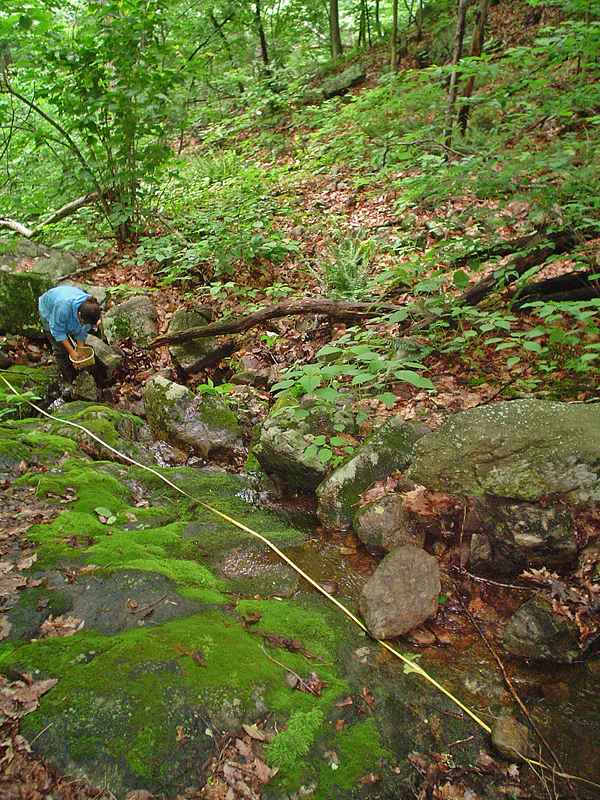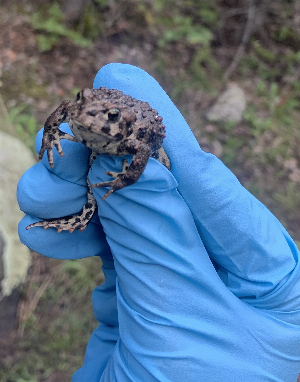Monitoring and Population Ecology
Advances in technology (e.g., PIT tags) have allowed scientists to individually mark more types of species than ever before, and concurrent developments in biometrics have allowed scientists to ask more types of questions about animal populations under more circumstances. Some of these developments have been particularly useful when estimating parameters about amphibians, a group that can be difficult to sample (e.g., multiple life stages, small size, difficult to mark, high juvenile mortality).
These developments in marking and estimation have allowed scientists to ask specific questions about the effects of potential stressors or beneficial management actions on amphibian populations, and quantify these responses.

Monitoring and Population Ecology - ARMI Papers & Reports
Papers & Reports Of toads and tolerance: Quantifying intraspecific variation in host resistance and tolerance to a lethal pathogen
Authors: Bennett Hardy; Erin Muths; W C Funk; Larissa L Bailey
Date: 2024-05-30 | Outlet: Journal of Animal Ecology
Due to the ubiquity of disease in natural systems, hosts have evolved strategies of disease resistance and tolerance to defend themselves from further harm once infected. Resistance strategies directly limit pathogen growth, typically leading to lower infection burdens in the host. A tolerance approach limits the fitness consequences caused by the pathogen but does not directly inhibit pathogen growth. Testing for intraspecific variation in wild host populations is important for informing conservation decisions about captive breeding, translocation, and disease treatment. Here, we test for the relative importance of tolerance and resistance in multiple populations of boreal toads (Anaxyrus boreas boreas) against Batrachochytrium dendrobatidis (Bd), the amphibian fungal pathogen responsible for the greatest host biodiversity loss due to disease. Boreal toads have severely declined in Colorado (CO) due to Bd, but toad populations challenged with Bd in western Wyoming (WY) appear to be less affected. We used a common garden infection experiment to expose post-metamorphic toads sourced from four populations (2 in CO and 2 in WY) to Bd and monitored changes in mass, pathogen burden, and survival for eight weeks. We used a multi-state modeling approach to estimate weekly survival and transition probabilities between infected and cleared states, reflecting a dynamic infection process that traditional approaches fail to capture. We found that WY boreal toads are highly tolerant to Bd infection with higher survival probabilities than those in CO when infected with identical pathogen burdens. WY toads also had higher probabilities of clearing infections and took an average of five days longer to reach peak infection burdens. Our results demonstrate strong intraspecific differences in tolerance and resistance that explain why population declines vary regionally across the species. We used a robust, multi-state framework to gain inference on typically hidden disease processes when testing for host tolerance or resistance and demonstrated that describing an entire species as ‘tolerant’ or ‘resistant’ is unwise without testing for intraspecific variation in host defenses.
Data Release Amphibian (chorus frog, wood frog, tiger salamander) surveys in Rocky Mountain National Park (1986-2022)
Authors: Amanda M Kissel; Erin Muths
Date: 2023-01-24 | Outlet: sciencebase
This data release contains information collected during surveys for chorus fogs (Pseudacris maculata), wood frogs (Lithobates sylvaticus) and tiger salamanders (Ambystoma mavortium) conducted in Rocky Mountain National Park (1986 – 2022) by the U.S. Geological Survey. Survey methods included visual encounter and aural surveys, and dip netting. Data collected between 1986 and 1994 focused on named water bodies in Rocky Mountain National Park. Data collected between 1995 and 1999 are from focal monitoring sites as well as sporadic surveys of other wetlands. Data collected between 2000-2002 represent repeated surveys conducted between 1986 and 1994 (e.g., park-wide surveys of named water bodies) and additional surveys of unnamed waterbodies. Data collected after 2002 were collected under an occupancy framework. Sites were identified within pre-defined catchments using the National Wetlands Inventory Database to locate potential amphibian breeding habitat (e.g., ponds, ephemeral wetlands). If appropriate sites were encountered in the field and were not indicated on National Wetland Inventory databases (https://www.fws.gov/program/national-wetlands-inventory/metadata), they were added as incidental sites. Waterbodies were visited and surveyed at least two times during the amphibian active season (May and mid-August). Water bodies were surveyed for all life stages of amphibians.
Data Release Student Network for Amphibian Pathogen Surveillance Data: U.S. Geological Survey data release
Authors: Megan E Winzeler; Daniel A Grear
Date: 2023-05-16 | Outlet: USGS Science Base
Data in this dataset were collected as a part of the Student Network for Amphibian Pathogen Surveilance (SNAPs) program throughout the United States by undergraduate students in biology or ecology courses as a part of their curriculum throughout 2022. This data was collected in the field by students and sent to the USGS National Wildlife Health Center (NWHC) for testing of two amphibian fungal pathogens, Batrachochytrium dendrobatidis (Bd) and Batrachochytrium salamandrivorans (Bs). The dataset includes both the field records of the individual amphibians tested and the results for individuals for Bd and Bsal
View All Data Releases on Monitoring and Population Ecology
* USGS neither sponsors nor endorses non-USGS web sites; per requirement "3.4.1 Prohibition of Commercial Endorsement."
* PDF documents require Adobe Reader or Google Chrome Browser for viewing.
* PDF documents require Adobe Reader or Google Chrome Browser for viewing.


